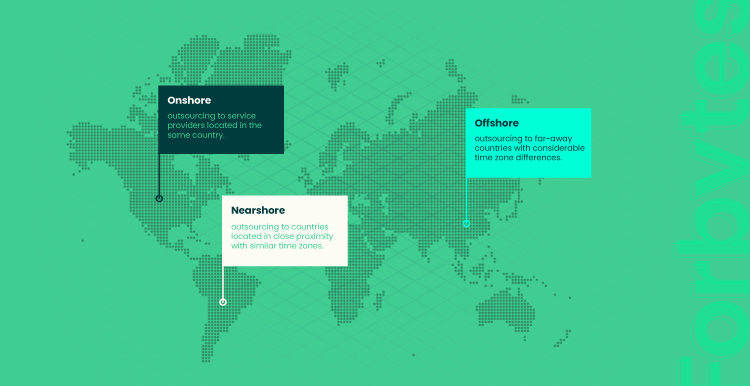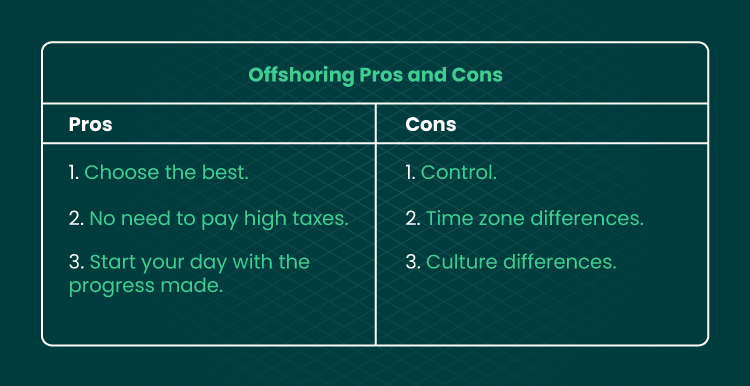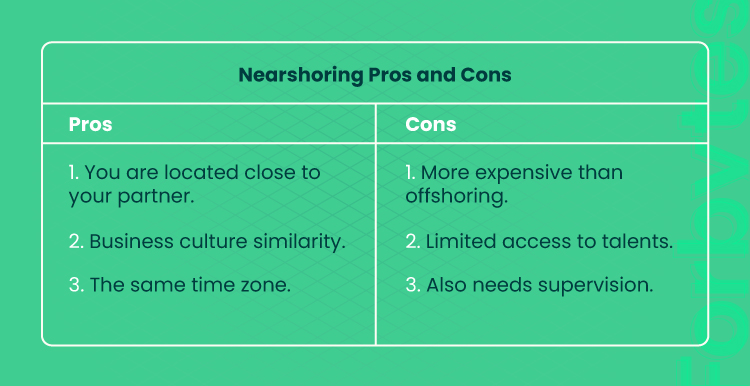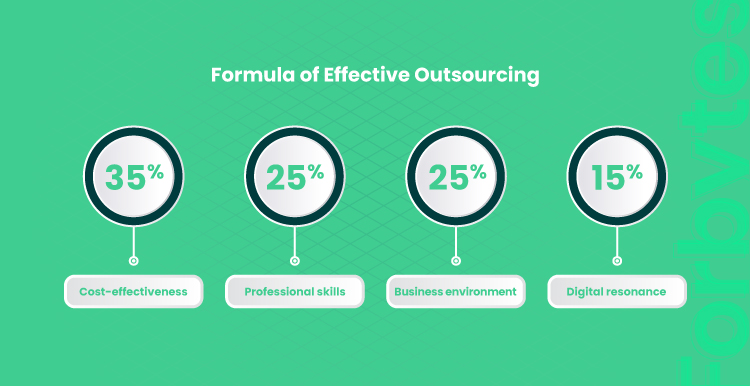Developing a software product is a tricky task. You need to stay efficient, prioritize quality, and keep your business operations in focus at the same time. How to meet all your interim goals and come up with an engaging solution? 70% of businesses know the answer — to outsource.
This time, we explain the key differences between business process outsourcing and outstaffing. Let’s discuss what types of outsourcing you can choose from, what their pros and cons are, and what risks to consider while making a decision. But before, let us briefly remind you of what outsourcing is.
What Is Outsourcing?
Outsourcing refers to hiring a third-party vendor that provides specialized services. Usually, the vendor offers software engineering capability in different technologies. The vendor can have software development teams of different sizes and skill sets. The scheme for hiring an outsourcing software development company is pretty simple. You contact the company and they get in touch with you. Together, you discuss the requirements, goals, and expectations of a product. Then, the company picks out the best fit of professionals for your project based on the deadlines and budget. Finally, you create a project roadmap and start working.
Outsourcing vs Outstaffing
At first glance, it seems that outsourcing business activities and outstaffing mean the same. In both outsourcing and outstaffing, you hire a third-party vendor that encompasses numerous software development teams. But in outstaffing, you get not the services provided by IT professionals but the team of IT professionals itself.
So, the difference between outsourcing and outstaffing lies in what you get in the end. In outsourcing, a software development team works for a third-party vendor and providers you with product engineering services. You get software development services. Together with the vendor, you discuss the scope of the software development process, deadlines, budget, and product requirements. Then, you get experts who implement your product idea into reality step-by-step.
When to choose outsourcing? When you haven’t an in-house software development team and need to build a software product. You can delegate all managerial tasks to an outsourced project manager if you want to focus solely on running your business.
These are the benefits that business process outsourcing gives you:
- Fewer costs. Due to the economic factors that vary across countries, the hourly rate for software development services differs accordingly. Companies outsource to hire high-level professionals at a lower price.
- Greater choice of skills. Global access to talents increases the chances of finding the best fit for your project. You can base your choice not only on hard skills but also soft skills, which are highly needed for effective communication.
- Flexibility. An outsourcing company adjusts the team size and roles according to your business operations and business processes. Moreover, as your project scales up or down, your agreement with the vendor can be reviewed and adjusted to the changes. Usually, the agile approach to software development is used, which also adds adaptivity and reduces risks.
The risks include:
- Confidentiality. An external organization gets access to your confidential data. These may include valuable data on your strategy development, market tactics, etc. You need to be confident in your service provider to entrust them with sensitive data.
- Data security. If a company builds a solution for your business, they need to integrate your data into this product. That is, outsourcing requires you to share your customers and business data with third parties. To reduce cybersecurity threats associated with this business process, sign a DPA agreement with the partner.
- Lack of transparency. Some remote service providers neglect the aspect of communication. They do not provide a client with regular updates on the development. Closer to the end, it may turn out that the team heavily lags behind the schedule.
In outstaffing, a software development team works for you while an external organization takes care of office maintenance, taxes, etc. You get a software development team to augment your own staff. You get the needed experts, distribute tasks, and manage all business operations by yourself. If you choose this approach, check the tips for successful project management.
When to choose outstaffing? When you pursue long-term needs that do not limit to building a software product. Usually, outstaffing is chosen by companies that want to hire experts from abroad but do not want to deal with bureaucracy.
Outstaffing provides companies with the following advantages:
- More control with less headache. Most of the responsibilities associated with managing outstaffed experts are imposed on the outstaffing company. They manage such business processes as employee vacations, sick leaves, hiring, and so on. You get a professional who is ready to work.
- Fewer costs. Like outsourcing, outstaffing is usually chosen for cost-saving. Many countries ensure pretty much the same quality of software development services but at different prices.
- You reach goals quicker. The new employees hired under outstaffing facilitate business operations and the process of reaching your goals. You cover the gaps that weaken your team by choosing people with the right skills.
Meantime, the disadvantages of this model are as follows:
- Not the best choice for short-term projects. Outstaffing means that you need professional service on a regular basis. Outsourcing is better for short-term tasks as it gives you a clear vision of when the project starts, when it ends, and how things will be going.
- Narrower access to talents. As a rule, this model does not give as wide access to the talent pool as outsourcing does. Also, it is more time- and effort-consuming compared to outsourcing as you need to clarify whom you need on your own.
- Differences in work approach, culture, and habits. It may happen that the tempo of the hired professional or approach to work does not fit your team. Since you bear responsibility for the work process, it may be hard to set the connection between a newcomer and a complete in-house team.
Now that you know the difference between outstaffing and outsourcing, it’s time to have a look at the main types of the latter. Offshore vs nearshore vs onshore: what’s the best? We will find out.

What Is Offshoring?
Many people ask about the difference between offshoring and outsourcing. In fact, offshoring is one of the types of outsourcing so we cannot contrast these two terms. Offshore IT outsourcing is a model under which you hire a software development company from a distant country. For instance, for a US business entity, it may be Ukraine or Poland. Outsourcing offshoring is the best choice for businesses with a tight budget. Because of the economic conditions that differ across countries, you can hire excellent software engineers at a lower cost. This, in turn, leads to operating cost improvement on the project.
Why Is Offshoring Cheaper?
This is one of the most commonly misunderstood aspects of offshoring. Offshore services are indeed more affordable. But it does not mean that software engineers in distant countries are less skilled and, therefore, earn less. Sure, if you compare their salary with what engineers in your country earn, it may seem suspicious. But you need to consider the fact that the living standards and prices for goods and services are not equivalent for all countries. Let’s check what it means based on the living wage.
A living wage is a minimum wage needed to ensure a normal life for a person and satisfy all their basic needs. This is not the same as the subsistence minimum, which denotes the minimum income needed for biological survival. In the USA, the living wage is nearly $5700. Meantime, in Poland, the living wage is around $445. As you see, paying 5 minimum wages in the USA and Poland will not mean the same. The principles of building wage policy consider the metrics like minimum wage. So, you get the chance to hire a skilled professional for your offshoring project at a lower price.

Offshoring Advantages
- Choose the best. You get access to a global variety of talents, specialized skills, and competencies. If you need a particular combination of skills, offshoring can satisfy even the most specific requests.
- No need to pay high taxes. You can outsource to a country where there are fewer legal obligations imposed on companies. Your biggest concern will only be choosing the right people for the right business functions.
- Start your day with the progress made. Because of the possible differences in time zones, you can start your morning at work with the updates received from your outsourced team. It saves you time and facilitates business operations. Whenever you need to change something on the project, it is done when you sleep.
Offshoring Drawbacks
- Control. It is challenging to entrust your business processes to an external organization and people you have never seen. Therefore, the collaboration responsibilities, rules, and obligations should be well documented.
- Time zone differences. This turns into a drawback when there is a need to fix something ASAP. But if you hire a reliable product engineering company, they will test code multiply before deploying any changes, which minimizes the risks of urgent problems.
- Culture differences. Communication styles are determined by the culture, which may have an impact on the quality focus of the project. But as a rule, this is an outsourcing provider that does its best to adjust to the client’s culture and communication preferences.
What Is Nearshoring?
The nearshoring definition sounds as follows: outsourcing to a neighboring or nearby country. Usually, we use this term to mark the cooperation with a company located on the same continent as you. If we compare offshoring and nearshoring, the great advantage of the latter is that it enables you to visit your outsourcing partner.
For example, you can organize face-to-face meetings once a few weeks or months. This will help you set the personal connection, motivate the team, learn more about the inside subtleties of their work, and get more control over the core activities. Also, you can invite the chosen nearshoring team to your office for them to fully embrace your business. So, the nearshore vs offshore comparison means outsourcing to a neighboring country vs a distanced country.

Nearshoring Benefits
- You are located close to your partner. It eases the process of cooperation: you can get in touch instantly, use the same apps and tools for communication, and organize face-to-face events when necessary.
- Business culture similarity. The business acumen of yours and your partner is based on similar or the same values. Business ethics is also similar, which prevents conflicts from happening.
- The same time zone. You are at the same work pace as your nearshoring partner. You move together from step to step and get in touch at any convenient time with no need to adjust to each other.
Nearshoring Risks
- More expensive than offshoring. Offshore vs nearshore outsourcing differs in terms of costs. Developed countries are often the source of innovations and discoveries. This is why the pricing for software development services there may be higher than in developing countries.
- Limited access to talents. You choose from a limited list of countries. It narrows your choice of a partner and makes it more time-consuming to find the best fit. Even when the technology architecture may be exactly the one you are looking for, it does not guarantee that your choice is right.
- Also needs supervision. Like offshoring, nearshoring requires your attention and focus. You need to control the development process and make sure that remote engineers succeed with their tasks and deadlines.
What Is Onshoring?
Onshoring is when you outsource to a company located in the same country. You may be based in one city, while another city of your country is considered a real capital of software development. This is when you may need onshoring. Greater choice of a partner, better pricing, more favorable conditions of cooperation — these factors make businesses onshore software development.

Onshoring Pros
- The same language. Usually, software engineering companies that offer outsourcing services for the global audience have high English language skills. Still, talking in your language with other native speakers makes it easier for you to clearly explain what you expect to get. Also, it enables you to add some emotional connotation to cooperation whenever appropriate.
- The convenience of cooperation. You and your partner are based in close proximity to each other. It enables you to communicate face-to-face frequently and makes cooperation more convenient. Moreover, onshoring allows you to use your intuitive skills to choose the right people to work with.
- The awareness of the target market in your country. If you build a product for the audience living in your country, onshoring will give you the chance to work with people with a deep understanding of your target customer.
Onshoring Cons
- Can be expensive. Very often, it is a better idea to offshore or nearshore to save money. You can spend this money on advertising and promotions of your product instead. Don’t believe that offshoring means hiring less competent people. This is a complete myth debunked by hundreds of successful offshoring projects. Countries like Ukraine or Poland have a lot of skilled professionals in the IT-sphere. This is also proven by the fact that many of them work in Silicon Valley for recognized international corporations.
- High chance that competitors build similar products. If you all operate in the same region, the chances are that you and your competitors use the same market data to analyze client needs, interests, etc. By doing so, both of you increase the possibility of building a product that already has more popular analogs.
- Less creativity and fewer insights when working. Offshoring and nearshoring open new horizons and give the inspiration to make unique products. Onshoring, in turn, makes you stay in your comfort zone.
Best Countries for Outsourcing in Eastern Europe
Eastern Europe is the best solution for businesses that want to access a big pool of tech experts, work with people having high English proficiency, and save money on development. Let’s compare four main outsourcing destinations in this region, which include Romania, Ukraine, Poland, and Hungary.

Romania

Romania is a country offering its citizens wide educational opportunities. It has formed the ground for the growth of the IT sector and the rise of the number of IT professionals. Last year, the export of Romanian IT services was valued at more than $5 billion. The figure is growing at 20% each year.
Tech plays an important role in the Romanian economy, being supported by the government in a number of ways. Students get tuition-free opportunities to study IT and take part in international programs. Another big advantage is the country’s strategic location. Cluj-Napoca attracts investors from all over the world, making Romania the country with an ever-growing number of startups and innovations. Quality over quantity — this is what you will find when outsourcing to Romania.
Ukraine

Ukraine is a happy medium among all outsourcing destinations in Eastern Europe. It has lower hourly rates compared to Poland but provides professionals with the same level of expertise. The biggest cities of Ukraine offer various educational opportunities in the sphere of tech and prepare experts for a range of tech-related jobs. Moreover, tech companies based in Ukraine also ensure continuous education for their employees and give them access to foreign sources of knowledge. Considering that many foreign companies open their offices in Ukraine, we may assume that this country is a rapidly developing source of talent.
When it comes to the mentality question, Ukrainians are hard-working people who are not afraid of responsibility and challenges. Their motivation lies in the contribution they make to the common goal. This is why you will have no trouble while working with Ukrainian partners. We also want to highlight that the English proficiency level is high for managing business activities effectively. The opportunity to boost English skills is offered by most software development companies in Ukraine. This makes it easy for foreign partners to find a common language with the hired team.
Poland

Poland is one more outsourcing destination worth your attention. The IT sector is well-developed in this country, attracting professionals from all over Europe. There are lots of big and small-size companies offering software development services. Also, many world-known companies are represented in this country.
Among the best skills of Polish engineers, clients mention concentration, good work ethics, and innovation. PHP and Java are the widely spread languages of Polish developers. Professionals in Poland are also strong at user experience design and quality testing. The hourly rate is quite higher compared to Ukraine because of the higher economic standards of this country.
Hungary

Hungary is known for a large number of IT freelancers, with more than 3000 IT students graduating each year. Hungarian universities provide reliable education in this sector, which increases the number of skilled professionals. When it comes to the choice of programming languages, the trend in this country reproduces the global one.
Hungary is one of the offshoring countries that are located in a convenient time zone. There is only a 6-hour difference between Hungary and the USA. Moreover, if a client is located in Central Europe, the flight time for them to travel to Hungary will take 2-4 hours, which is quite a manageable task.
Summing It Up
This article was aimed to put an end to the confusion between offshoring, nearshoring, and onshoring. Now, you know that the difference is simple and easy to understand. All three terms refer to the types of business process outsourcing. The difference between them lies in the distance between your country and the country where a partnering company is based. As you see, the question of the difference between outsourcing and offshoring is irrelevant because outsourcing and offshore are synonyms.
Also, we gave you some suggestions of the best countries in Eastern Europe where you can outsource. When choosing, you need to consider how many IT specialists the country has, whether it is fluent in English and competent in IT, whether the culture of a country is adaptable and open to international cooperation, etc. When you choose the country and narrow your choice to 3-5 companies, get in touch with them and ask for a meeting. It will help you to understand whether you are on the same page, share the same values, and have the same vision for your potential product.
If you need help with any of these stages from IT consultation to product engineering — we are waiting for your contact details to talk.

Our Engineers
Can Help
Are you ready to discover all benefits of running a business in the digital era?

Our Engineers
Can Help
Are you ready to discover all benefits of running a business in the digital era?








